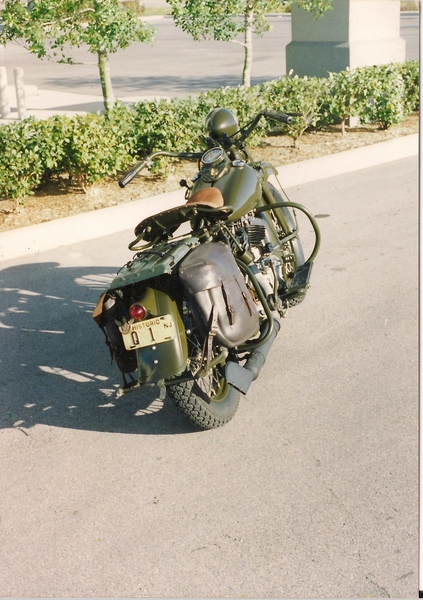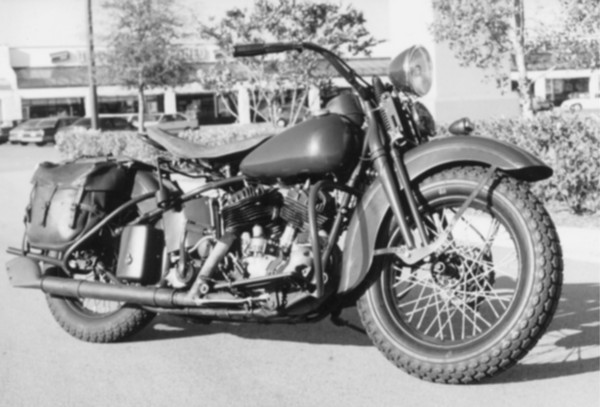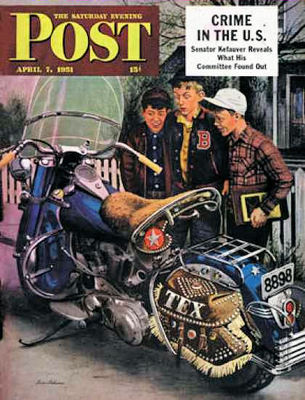Welcome to
37ul.com
Sarge, Where did the name "Ol' Tex" come from for your '37?
To tell the truth, I didn't name it. The name is all intertwined with the way I came to own the bike. That leads to a long, complicated story, and, oh, well! Okay.

The first motorcycle registered under the "Historic" Motor Vehicle Law in New Jersey, 1976
In the Spring of 1970 I was still on my first enlistment in Uncle's green machine. Coming back as a nineteen-year-old kid from a certain former French Colony in Asia with orders for Fort Sill, Oklahoma, in August 69, I had already learned a couple of tricks to "dancin' around the Army." My parents still lived on the family homestead in South Jersey where I grew up. So, that's where I wanted to go.
Early in my 30 day leave, I took a trip to the Pentagon in Washington, and found that there was a special office already set up in the Army Personnel Office for returning vets like me, (I'll never forget the address: Pentagon room # 1-D-687, First Floor, "D" Ring, etc.) and in no time flat I was reassigned to Fort Dix, NJ, forty miles from home and where I'd gone through Basic and Advanced Training, two years before.
I was driving the folks' 1961 Ford Galaxie temporarily, but I needed wheels of my own. I'd had a leetle Yamaha before going overseas the year before, and what I wanted was a motorcycle. I went through about four bikes in the next year: a Honda 160 twin, Kawasaki 250 twin, 'nother Honda, a 305, and a Yamaha 180 twin. That last one was a "ladies" twin street bike, is all I can call it; blue and chrome, low pipes, electric starter and turn signals.
I couldn't stand stateside ("polish your boots to high-gloss, spit shine" and "You need a haircut, Soldier!") army life, after all. Before the year was out, I'd volunteered to go back to the jungle; just for fun, more'n anything. I got the orders and in about June, 1970, was on leave at home, waiting a Port Call to fly across the Pacific once again, from Oakland Overseas Replacement Station in July. ("One, two, three, What are we fighting for? Don't ask me, I don't give a damn! Next stop is Viet nam!")
One day I was playing softball with some of my nearest neighbors there in rural South Jersey, half-a-mile or so from home. They were kids I'd grown up with, but younger, and still in high school. I was in the 'outfield,' in their backyard, that bordered on their neighbors' backyard; people I didn't know. This backyard was mowed, short, green grass, but adjacent was an overgrown area behind those folks' barn.
So, I chased the ball when it was hit past me, into the weeds, and I nearly fell over a, a, motorcycle! I had no idea what it was, but it was old, and I wanted it! I saw those big ol' iron cylinders and the wheels were on it. I didn't know if it was a Harley or an Indian or what, but I was in love. It had no front fender, the tip was missing from the back fender, no seat, no exhaust system or floorboards. But the sparkplugs were intact, meaning the inside of the cylinders hadn't been exposed to the weather. Remember, "Easy Rider" had just come out in 1969, and everyone wanted a 'chopper!'
The boys introduced me to their neighbor, Bob Grasso, when he came home from work, later. Bob was an old time Harley rider. He worked at the Deepwater, New Jersey, DuPont Dye Works, about thirty miles south, right on the banks of the Delaware River, across from the State of Delaware. The conditions there were terrible. You could literally tell if someone worked at the dye works by their cars. The atmosphere that rained down on the parking lot ate the paint off of all the horizontal surfaces in short order. And it eventually killed Bob, too. God rest his soul.
It turned out that Bob was quite a decent fellow. The deal we finally struck was a trade: my running, registered 180 Yamaha for the old Harley, and he was just then starting two weeks' vacation, and with his houseful of kids, wasn't going anywhere, so he agreed to help me get the Old Harley running. The Yamaha was then worth about three hundred bucks. I think I came out on top in the deal. But, looking back on it, I also think that maybe Bob planned it that way.
He explained to me that it had belonged to a fellow from Woodbury Heights, NJ, who worked 8 to 5 at a factory in Woodstown. He ran the bike back and forth every day, until one day, about six years before I fell into it, it was stolen from the parking lot where he worked. Some time later, the cops recovered it and put it in the impound lot and called him.
He, in turn, called Bob, saying that he didn't have the money to get it out of impound, and that he didn't particularly want it, anyway, so Bob could have it for the cost of the getting out of impound. And he gave Bob the signed NJ title for the 1937 Model "UL" sidevalve 74. Bob rolled it behind his barn and left it. Nobody wanted a "damned old Flathead" in those days. Nicky Muth, of Williamstown, then building up his chopper shop in old family chicken coops, even took a bye on it when Bob offered it to him, Bob told me.
I didn't know squat about Harleys, but I'm mechanical, thanks to many sessions watching and helping my dad build and fix things of every kind when I was little. He was, literally, a "first class mechanic," and he worked at a shipyard. Self-taught, he could do almost anything, from brick and concrete work, to carpentry, to fixing cars and machines. Most relevant to the task at hand, I remember watching him and asking questions, about 12 years old, as he took apart a Briggs and Stratton sidevalve lawnmower engine in our basement; sent the important bits out to a machine shop for valves and cylinder bore and bearing fit and such, and when it was all done, he put it back together, and it ran like new. That was my introduction to infernal combustion engines and the four stroke Otto Cycle mechanism. Anyway, Bob provided most of the tools, and many parts to replace the ones that were missing, that he had stashed over the years in that barn next to his ride, a perfect, low-miles 1962 Duo-Glide. That bike was immaculate. Nicky finally ended up with it in his museum.
I got some old exhaust pipes and marked and hacksawed them, and a welder friend put the pieces together into a Flathead exhaust system for me. As I remember, it was a rear drag pipe that I cut a hole in the corner of, and I connected a home-made "S" pipe from a pieced-together front downpipe into. You couldn't buy a reproduction Flathead Big Twin exhaust system in those days, or much of anything for a UL. I was lucky that the chassis is identical to the Knucklehead. There were Knucklehead chopper parts just then becoming available.
One of my most propitious finds was an original Flathead Big Twin "Operator's Instructions" folder they sold me, for the original fifty cent price, over the parts counter at old Philadelphia Harley-Davidson, on North Broad Street. They'd been in the same location for years, and they also had what i went over there for: a Flathead return oil pump. That's the oil return gear pump on the bottom of 45s and U model Big Twins that incorporates a rotary breather valve. Mine was shot. That Operator's Instructions folder told me how to set the points, take apart and reinstall the 4-bolt 36-40 clutch, and even how to line up the timing marks on the four cams after I took the cam cover off to install the oil pump.
The engine was frozen, after sitting for six years; so, towards the end of one day working on it, I took out the sparkplugs, shot both cylinders pretty well full with WD-40, put the plugs back in, and let it sit overnight. 'Next morning, I took apart the tin primary and put a big wrench on the engine sprocket nut, and started "urging" it this way and that, back and forth. After a bit, it moved. Then it went all the way around, and I knew I had it made. I put the primary back together and kicked it, and soon, everything was loosened up. Finally, with a new battery, wires and enough ignorance of what I'd left undone to fill an encyclopedia, I started it up right there in the back yard, with an audience, of course.
My first time with a hand shift-foot clutch was unforgettable! I put down the heel, snicked it into gear, and when I let it off, the bike shot off and the front of the toe of the clutch pedal caught under the aluminum footpegs I'd put on it. There was no way to disengage it! I went across the property line, into the rose bushes back over in my friends' back yard, fell over, and the engine, blessedly, stalled. I was always careful about clutch pedal interference after that.
Years later, probably ten, I met Bob Grasso's widow, vending out back one weekend day at the Berlin Farmers' Market in New Jersey. That was when I found out that Bob had passed away. She asked me if I still had "Ol' Tex." I knew what she meant, so I told her, yes, it had been through a couple of incarnations since then, but what did she mean, "Ol' Tex?"
She explained that when Bob's and her four children were little, they used to play on the rusting hulk in their backyard, and that they had named it "Ol' Tex." I had just called it "The '37 Flathead" until then, so I thought that was an appropriate moniker, and I've called it that ever since; through innumerable girlfriends, four wives (until I finally found my "keeper," twenty two years ago!'), and more "lives" than an accident-prone cat!
--Sarge, Fla




